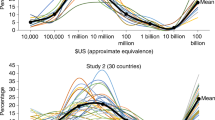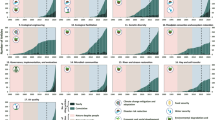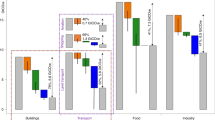Abstract
Financial advisers recommend a diverse portfolio to respond to market fluctuations across sectors. Similarly, nature has evolved a diverse portfolio of species to maintain ecosystem function amid environmental fluctuations. In urban planning, public health, transport and communications, food production, and other domains, however, this feature often seems ignored. As we enter an era of unprecedented turbulence at the planetary level, we argue that ample responses to this new reality — that is, response diversity — can no longer be taken for granted and must be actively designed and managed. We describe here what response diversity is, how it is expressed and how it can be enhanced and lost.
This is a preview of subscription content, access via your institution
Access options
Access Nature and 54 other Nature Portfolio journals
Get Nature+, our best-value online-access subscription
$29.99 / 30 days
cancel any time
Subscribe to this journal
Receive 12 digital issues and online access to articles
$119.00 per year
only $9.92 per issue
Buy this article
- Purchase on SpringerLink
- Instant access to full article PDF
Prices may be subject to local taxes which are calculated during checkout



Similar content being viewed by others
References
Davis, K. F., Downs, S. & Gephart, J. A. Towards food supply chain resilience to environmental shocks. Nat. Food 2, 54–65 (2021).
Lempert, R. J. & Collins, M. T. Managing the risk of uncertain threshold responses: comparison of robust, optimum, and precautionary approaches. Risk Anal. 27, 1009–1026 (2007).
Garnett, P., Doherty, B. & Heron, T. Vulnerability of the United Kingdom’s food supply chains exposed by COVID-19. Nat. Food 1, 315–318 (2020).
Abson, D. J. et al. Leverage points for sustainability transformation. Ambio 46, 30–39 (2017).
Westley, F. et al. Tipping toward sustainability: emerging pathways of transformation. Ambio 40, 762–780 (2011).
Steffen, W., Broadgate, W., Deutsch, L., Gaffney, O. & Ludwig, C. The trajectory of the Anthropocene: the Great Acceleration. Anthr. Rev. 2, 81–98 (2015).
Jouffray, J.-B., Blasiak, R., Norström, A. V., Österblom, H. & Nyström, M. The blue acceleration: the trajectory of human expansion into the ocean. One Earth 2, 43–54 (2020).
Adger, W. N., Eakin, H. & Winkels, A. Nested and teleconnected vulnerabilities to environmental change. Front. Ecol. Environ. 7, 150–157 (2009).
Nyström, M. et al. Anatomy and resilience of the global production ecosystem. Nature 575, 98–108 (2019).
Mason, W. & Watts, D. J. Collaborative learning in networks. Proc. Natl Acad. Sci. USA 109, 764–769 (2012).
Helbing, D. Globally networked risks and how to respond. Nature 497, 51–59 (2013).
Worm, B. & Paine, R. T. Humans as a hyperkeystone species. Trends Ecol. Evol. 31, 600–607 (2016).
Crutzen, P. J. & Stoermer, E. F. in The Future of Nature (eds Robin, L. et al.) 479–490 (Yale Univ. Press, 2017); https://doi.org/10.12987/9780300188479-041
Ellis, E. C. Anthropogenic transformation of the terrestrial biosphere. Phil. Trans. R. Soc. A 369, 1010–1035 (2011).
Senevirante, S. I. et al. in Climate Change 2021: The Physical Science Basis (eds Masson-Delmotte, V. et al.) 1513–1766 (IPCC, Cambridge Univ. Press, 2021).
Frank, A. B. et al. Dealing with femtorisks in international relations. Proc. Natl Acad. Sci. USA 111, 17356–17362 (2014).
Folke, C. et al. Our future in the Anthropocene biosphere. Ambio 50, 834–869 (2021).
Walker, B. & Salt, D. Resilience Practice: Building Capacity to Absorb Disturbance and Maintain Function (Island Press/Center for Resource Economics, 2012); https://doi.org/10.5822/978-1-61091-231-0
Biggs, R., Schlüter, M. & Schoon, M. L. (eds) Principles for Building Resilience: Sustaining Ecosystem Services in Social–Ecological Systems (Cambridge Univ. Press, 2015); https://doi.org/10.1017/CBO9781316014240
Cervantes Saavedra, M. de & Rutherford, J. Don Quixote: The Ingenious Hidalgo de la Mancha (Penguin, 2003).
Coronese, M., Lamperti, F., Keller, K., Chiaromonte, F. & Roventini, A. Evidence for sharp increase in the economic damages of extreme natural disasters. Proc. Natl Acad. Sci. USA 116, 21450–21455 (2019).
Cottrell, R. S. et al. Food production shocks across land and sea. Nat. Sustain. 2, 130–137 (2019).
Elmqvist, T. et al. Response diversity, ecosystem change, and resilience. Front. Ecol. Environ. 1, 488–494 (2003).
Arrow, K. J. & Fisher, A. C. Environmental preservation, uncertainty, and irreversibility. Q. J. Econ. 88, 312–319 (1974).
Dixit, A. K. & Pindyck, R. S. Investment under Uncertainty (Princeton Univ. Press, 1994).
Markowitz, H. Portfolio selection. J. Finance 7, 77–91 (1952).
Sharpe, W. F. Capital asset prices: a theory of market equilibrium under conditions of risk. J. Finance 19, 425–442 (1964).
Cifdaloz, O., Regmi, A., Anderies, J. M. & Rodriguez, A. A. Robustness, vulnerability, and adaptive capacity in small-scale social–ecological systems: the Pumpa Irrigation System in Nepal. Ecol. Soc. 15, art39 (2010).
Levin, S. A. et al. Governance in the face of extreme events: lessons from evolutionary processes for structuring interventions, and the need to go beyond. Ecosystems 25, 697–711 (2022).
Peterson, G., Allen, C. R. & Holling, C. S. Ecological resilience, biodiversity, and scale. Ecosystems 1, 6–18 (1998).
Nyström, M. Redundancy and response diversity of functional groups: implications for the resilience of coral reefs. Ambio 35, 30–35 (2006).
Kummu, M. et al. Interplay of trade and food system resilience: gains on supply diversity over time at the cost of trade independency. Glob. Food Secur. 24, 100360 (2020).
Hedblom, M., Andersson, E. & Borgström, S. Flexible land-use and undefined governance: from threats to potentials in peri-urban landscape planning. Land Use Policy 63, 523–527 (2017).
Haldane, A. Rethinking the Financial Network—Speech by Andy Haldane (Bank of England, 2009); https://www.bankofengland.co.uk/speech/2009/rethinking-the-financial-network
Haldane, A. G. & May, R. M. Systemic risk in banking ecosystems. Nature 469, 351–355 (2011).
Carpenter, S. R., Brock, W. A., Folke, C., van Nes, E. H. & Scheffer, M. Allowing variance may enlarge the safe operating space for exploited ecosystems. Proc. Natl Acad. Sci. USA 112, 14384–14389 (2015).
Mouillot, D., Graham, N. A. J., Villéger, S., Mason, N. W. H. & Bellwood, D. R. A functional approach reveals community responses to disturbances. Trends Ecol. Evol. 28, 167–177 (2013).
Leslie, P. & McCabe, J. T. Response diversity and resilience in social–ecological systems. Curr. Anthropol. 54, 114–143 (2013).
Biggs, R. et al. Toward principles for enhancing the resilience of ecosystem services. Annu. Rev. Environ. Resour. 37, 421–448 (2012).
Anderies, J. M. Managing variance: key policy challenges for the Anthropocene. Proc. Natl Acad. Sci. USA 112, 14402–14403 (2015).
Csete, M. E. & Doyle, J. C. Reverse engineering of biological complexity. Science 295, 1664–1669 (2002).
Carlson, J. M. & Doyle, J. Highly optimized tolerance: robustness and design in complex systems. Phys. Rev. Lett. 84, 2529–2532 (2000).
Kitano, H. Biological robustness. Nat. Rev. Genet. 5, 826–837 (2004).
Csete, M. & Doyle, J. Bow ties, metabolism and disease. Trends Biotechnol. 22, 446–450 (2004).
Anderies, J. M., Rodriguez, A. A., Janssen, M. A. & Cifdaloz, O. Panaceas, uncertainty, and the robust control framework in sustainability science. Proc. Natl Acad. Sci. USA 104, 15194–15199 (2007).
Rodriguez, A. A., Cifdaloz, O., Anderies, J. M., Janssen, M. A. & Dickeson, J. Confronting management challenges in highly uncertain natural resource systems: a robustness–vulnerability trade-off approach. Environ. Model. Assess. 16, 15–36 (2011).
Charpentier, A. Insurability of climate risks. Geneva Pap. Risk Insur. Issues Pract. 33, 91–109 (2008).
Alfieri, L., Feyen, L. & Di Baldassarre, G. Increasing flood risk under climate change: a pan-European assessment of the benefits of four adaptation strategies. Climatic Change 136, 507–521 (2016).
Isakson, S. R. Derivatives for development? Small-farmer vulnerability and the financialization of climate risk management: small-farmer vulnerability and financialization. J. Agrar. Change 15, 569–580 (2015).
Müller, B. & Kreuer, D. Ecologists should care about insurance, too. Trends Ecol. Evol. 31, 1–2 (2016).
Walker, B. et al. Looming global-scale failures and missing institutions. Science 325, 1345–1346 (2009).
Berkes, F. et al. Globalization, roving bandits, and marine resources. Science 311, 1557–1558 (2006).
Walker, B. H., Langridge, J. L. & McFarlane, F. Resilience of an Australian savanna grassland to selective and non-selective perturbations. Austral Ecol. 22, 125–135 (1997).
Polasky, S. et al. Corridors of clarity: four principles to overcome uncertainty paralysis in the Anthropocene. BioScience 70, 1139–1144 (2020).
Engström, G. et al. Carbon pricing and planetary boundaries. Nat. Commun. 11, 4688 (2020).
Sun, J. C., Ugolini, S. & Vivier, E. Immunological memory within the innate immune system. EMBO J. https://doi.org/10.1002/embj.201387651 (2014).
Vély, F. et al. Evidence of innate lymphoid cell redundancy in humans. Nat. Immunol. 17, 1291–1299 (2016).
Grimm, N., Cook, E., Hale, R. & Iwaniec, D. in The Routledge Handbook of Urbanization and Global Environmental Change (eds Seto, K. et al.) Ch. 14 (Routledge, 2015).
Jiang, B., Mak, C. N. S., Zhong, H., Larsen, L. & Webster, C. J. From broken windows to perceived routine activities: examining impacts of environmental interventions on perceived safety of urban alleys. Front. Psychol. 9, 2450 (2018).
Andersson, E. et al. Urban climate resilience through hybrid infrastructure. Curr. Opin. Environ. Sustain. 55, 101158 (2022).
Douglas, M. & Wildavsky, A. Risk and Culture: An Essay on the Selection of Technological and Environmental Dangers (Univ. of California Press, 1983).
Weber, E. U., Ames, D. R. & Blais, A.-R. ‘How do I choose thee? Let me count the ways’: a textual analysis of similarities and differences in modes of decision-making in China and the United States. Manage. Organ. Rev. 1, 87–118 (2005).
Kunreuther, H. et al. in Climate Change 2014: Mitigation of Climate Change (eds Edenhofer, O. et al.) Ch. 2 (IPCC, Cambridge Univ. Press, 2014); https://www.ipcc.ch/site/assets/uploads/2018/02/ipcc_wg3_ar5_chapter2.pdf
Meadows, D. H. Thinking in Systems: A Primer (Earthscan, 2009).
Nyborg, K. et al. Social norms as solutions. Science 354, 42–43 (2016).
Hall, P. A. & Lamont, M. (eds) Social Resilience in the Neoliberal Era (Cambridge Univ. Press, 2013).
Norström, A. V. et al. Principles for knowledge co-production in sustainability research. Nat. Sustain. 3, 182–190 (2020).
United Nations Conference on Trade and Development Review of Maritime Transport 2017 (United Nations, 2017).
United Nations Conference on Trade and Development Review of Maritime Transport 2018 (United Nations, 2019).
Bailey, R. & Wellesley, L. Chatham House Report 2017: Chokepoints and Vulnerabilities in Global Food Trade (Energy, Environment and Resources Department, Chatham House, The Royal Institute of International Affairs, 2017); https://www.chathamhouse.org/sites/default/files/publications/research/2017-06-27-chokepoints-vulnerabilities-global-food-trade-bailey-wellesley-final.pdf
Khoury, C. K. et al. Increasing homogeneity in global food supplies and the implications for food security. Proc. Natl Acad. Sci. USA 111, 4001–4006 (2014).
Hendrickson, M. K. Resilience in a concentrated and consolidated food system. J. Environ. Stud. Sci. 5, 418–431 (2015).
Öborn, I. et al. Restoring rangelands for nutrition and health for humans and livestock. in The XXIV International Grassland Congress / XI International Rangeland Congress (Sustainable Use of Grassland and Rangeland Resources for Improved Livelihoods) (ed. National Organizing Committee of 2021 IGC/IRC Congress) (Kenya Agricultural and Livestock Research Organization, 2022).
Vulnerable Supply Chains—Interim Report (Productivity Commission, Australian Government, 2021); https://www.pc.gov.au/inquiries/completed/supply-chains/interim
Acknowledgements
This Perspective is the result of the Beijer Institute’s Askö meetings supported by the Beijer Foundation. M.N. was partly funded by a grant from the Swedish Research Council (no. 2020-04586). C.Q. was partly supported by the Swedish Marianne and Marcus Wallenberg Foundation (grant no. 2017.0137) and the FeedBaCks FORMAS/Era project (grant no. 2020-02360).
Author information
Authors and Affiliations
Contributions
B.W., A.-S.C., M.N., J.M.A., E.A., T.E. and C.Q. led the conceptualization and writing of the paper. All authors contributed to the conceptualization and editing. All authors have read and agreed to the published version of the manuscript.
Corresponding author
Ethics declarations
Competing interests
The authors declare no competing interests.
Peer review
Peer review information
Nature Sustainability thanks Terrence McCabe, Satish Ukkusuri and Jack Ahern for their contribution to the peer review of this work.
Additional information
Publisher’s note Springer Nature remains neutral with regard to jurisdictional claims in published maps and institutional affiliations.
Rights and permissions
Springer Nature or its licensor (e.g. a society or other partner) holds exclusive rights to this article under a publishing agreement with the author(s) or other rightsholder(s); author self-archiving of the accepted manuscript version of this article is solely governed by the terms of such publishing agreement and applicable law.
About this article
Cite this article
Walker, B., Crépin, AS., Nyström, M. et al. Response diversity as a sustainability strategy. Nat Sustain 6, 621–629 (2023). https://doi.org/10.1038/s41893-022-01048-7
Received:
Accepted:
Published:
Issue Date:
DOI: https://doi.org/10.1038/s41893-022-01048-7



